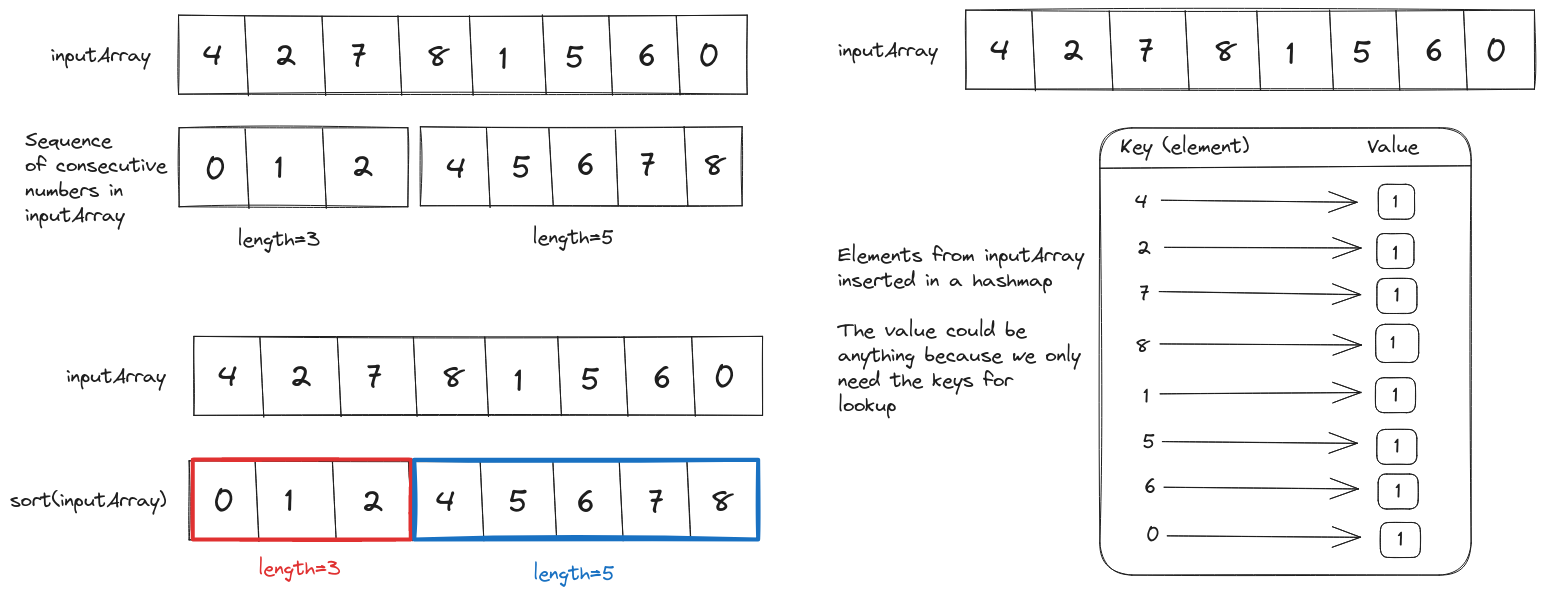Problem Statement
We have to implement the longestConsecutive function that takes an integer array as input and returns the length of the longest sequence of consecutive integers.
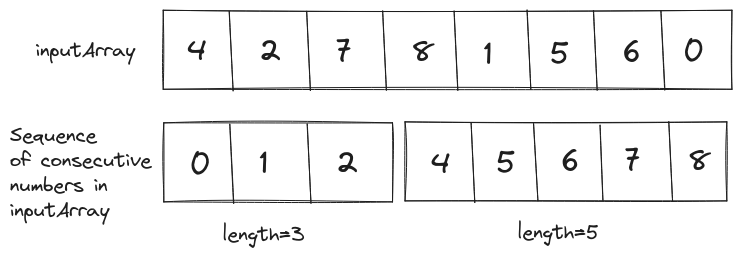
For example, in array [4, 2, 7, 8, 1, 5, 6, 0] we have two sequences of consecutive integers: [0, 1, 2] and [4, 5, 6, 7, 8]. The longest sequence ([4, 5, 6, 7, 8]) has length 5.
Brute Force Solution
It would be easier to find consecutive sequences if the input array is sorted.
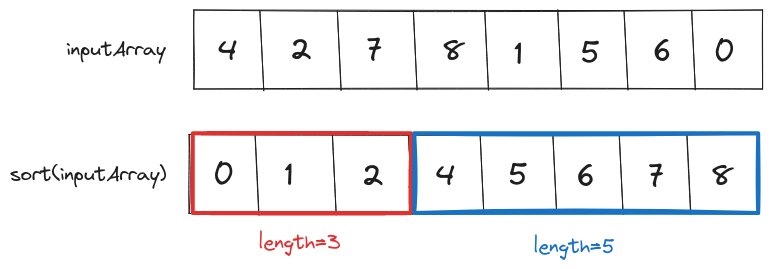
Once we have the sorted array we can iterate over it and find the longest sequence.
Psuedo-code for the Brute Force Solution
sortedInputArray = sort(inputArray)
longest_sequence_length = 0
sequence_length = 1
loop index in from 1 to len(sortedInputArray)
if sortedInputArray[index] - sortedInputArray[index-1]==1:
sequence_length += 1
else if sortedInputArray[index]==sortedInputArray[index-1]:
pass
else
sequence_length = 1
longest_sequence_length = max(longest_sequence_length, sequence_length)
Time Complexity Analysis
Best Case Scenario
For the best-case input, the brute-force solution will return the result in $O(n) + O(n \log(n))$ time. Since the time complexity of the best sorting algorithm will be $O(n \log(n))$ and the time complexity of iterating over the array is $O(n)$. We can simplify the total time complexity of the brute-force solution to $O(n \log(n))$.
Worst Case Scenario
In the worst-case scenario, the time complexity of the brute-force solution will be the same i.e. $O(n \log(n))$.
Space Complexity Analysis
We are assuming that the sorting operation is done in place for the elements in the input array. Thus, the space complexity of brute-force solution is constant i.e. $O(1)$.
Code for Brute Force Solution
package main
import (
"fmt"
"sort"
"math"
)
func longestConsecutive(nums []int)(int){
// For an empty input array the length of
// longest consecutive sequence will be 0
if len(nums)==0{
return 0
}
// The best sorting algorithm will sort in
// O(nlog(n)) time
sort.Ints(nums)
// This variable will contain the length
// of longest consecutive sequence
longestSequenceLength := 1
// Temporary variable to store the length
// of the current sequence
sequenceLength := 1
for index:=1;index<len(nums);index++{
if ((nums[index]-nums[index-1])==1){
// If the values at index and index-1
// are consecutive then increment the current
// sequence length by 1
sequenceLength+=1
} else if (nums[index]==nums[index-1]){
// If the values at index and index-1
// are the same then don't increment the current
// sequence length
sequenceLength+=0
} else {
// If the consecutive sequence is broken
// then reset the current sequence length to 1
sequenceLength=1
}
// On every iteration check if the length
// of the current sequence is greater than
// the value stored in longestSequenceLength
longestSequenceLength = int(math.Max(float64(sequenceLength),
float64(longestSequenceLength)))
}
return longestSequenceLength
}
func main(){
inputArray := []int{100, 4, 200, 1, 3, 2}
fmt.Println("Length of Longest Consecutive Sequence:",
longestConsecutive(inputArray))
inputArray = []int{4, 2, 7, 8, 1, 5, 6, 0}
fmt.Println("Length of Longest Consecutive Sequence:",
longestConsecutive(inputArray))
}
// Output
// Length of Longest Consecutive Sequence: 4
// Length of Longest Consecutive Sequence: 5
Optimized Solution
In terms of time complexity of the brute-force solution sorting is the most expensive operation ($O(n \log(n))$). We can eliminate it if we create a hashmap of elements in the array.
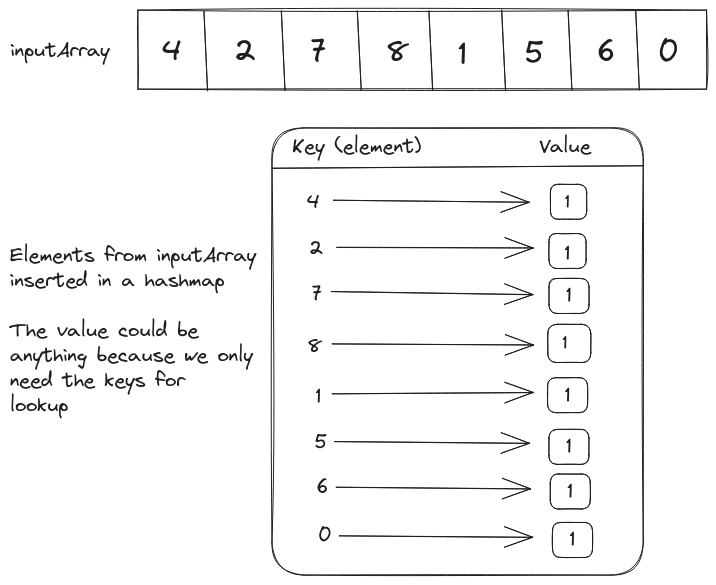
If the value is the first element in a consecutive sequence, it implies that value-1 does not exist in the inputArray. So we can iterate over all the elements in inputArray and identify the first elements of consecutive sequences by searching for inputArray[index]-1 in the hashmap.

Once we have found the first element of consecutive sequence we can keep looking for the next value in the hashmap until the sequence is broken.
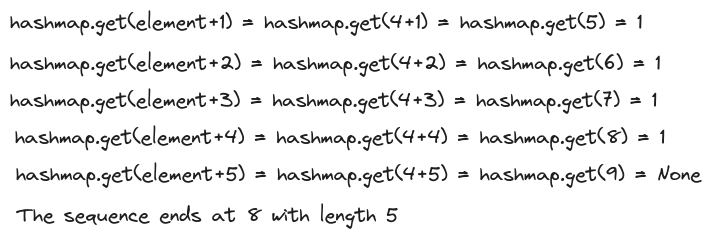
Psuedo code for the Optimized Solution
hashmap = HashMap()
loop value in inputArray
if not hashmap[value]
hashmap[value] = 1
longest_sequence = 0
sequence = 0
loop index in inputArray
value = inputArray[index]
if not hashmap[value-1]
while hashmap[value+1]
sequence += 1
value+=1
else
sequence = 1
longest_sequence = max(sequence, longest_sequence)
Time Complexity Analysis
Best Case Scenario
The loop executed to fill the hashmap has a fixed time complexity of $O(n)$.
If the input for the optimized solution contains only the sequences of length 1 then the nested while loop will not be executed. Thus, the total time complexity of the optimized solution in the best-case scenario will be $O(n) + O(n)$ or simply $O(n)$.
Worst Case Scenario
The check for hashmap[value-1] ensures that we are only looking for consecutive numbers upon encountering the first value. Thus, the total complexity of the worst-case scenario is also $O(n)$.
Space Complexity Analysis
The space complexity of the optimized solution is worse than the brute-force solution because it takes extra $O(n)$ space to store the hashmap.
Code for Optimized Solution
package main
import (
"fmt"
"math"
)
func longestConsecutive(nums []int)(int){
// Return 0 for the empty nums array
if len(nums)==0{
return 0
}
// Create a hashmap of all values in the nums array
hashmap := make(map[int]int)
for index:=0;index<len(nums);index++{
_, key_exists := hashmap[nums[index]]
if !key_exists{
hashmap[nums[index]] = 1
}
}
longestSequence := 1
sequence := 1
for index:=0;index<len(nums);index++{
value := nums[index]
_, key_exists := hashmap[value-1]
// If value-1 does not exist in the hashmap
// it is the start of a sequence
if !key_exists{
// Increment the value and sequence length
// until we can't find value+1 in the hashmap
for ;true;{
value+=1
_, key_exists = hashmap[value]
if key_exists{
sequence+=1
} else {
break
}
}
}
// Reset the value of longestSequence to the maximum
// of current sequence and the current value of
// the longestSequence
longestSequence = int(math.Max(float64(sequence),
float64(longestSequence)))
sequence = 1
}
return longestSequence
}
func main(){
inputArray := []int{100, 4, 200, 1, 3, 2}
fmt.Println("Length of Longest Consecutive Sequence:",
longestConsecutive(inputArray))
inputArray = []int{4, 2, 7, 8, 1, 5, 6, 0}
fmt.Println("Length of Longest Consecutive Sequence:",
longestConsecutive(inputArray))
}
// Output
// Length of Longest Consecutive Sequence: 4
// Length of Longest Consecutive Sequence: 5
Thank you for taking the time to read this blog post! If you found this content valuable and would like to stay updated with my latest posts consider subscribing to my RSS Feed.
Resources
128. Longest Consecutive Sequence
Leetcode 128 - LONGEST CONSECUTIVE SEQUENCE
